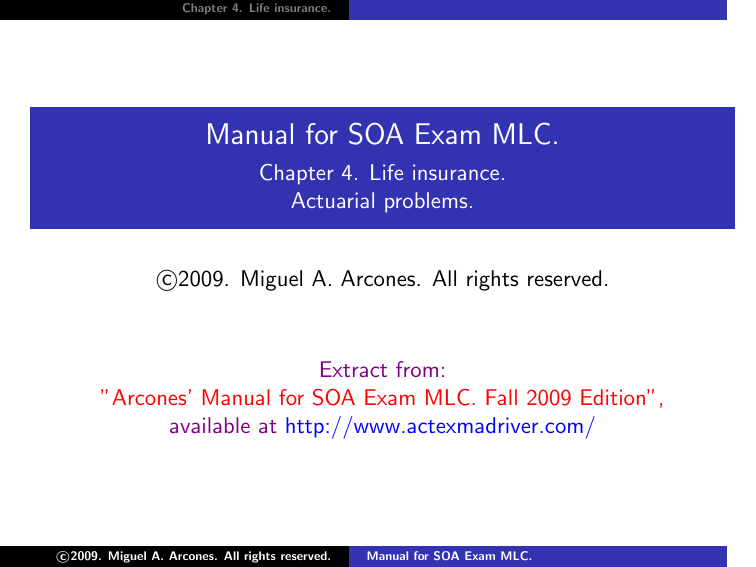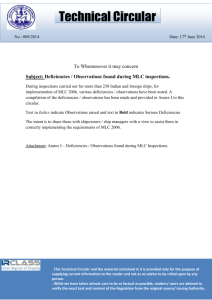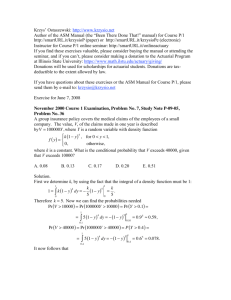
Chapter 4. Life insurance.
Manual for SOA Exam MLC.
Chapter 4. Life insurance.
Actuarial problems.
c
2009.
Miguel A. Arcones. All rights reserved.
Extract from:
”Arcones’ Manual for SOA Exam MLC. Fall 2009 Edition”,
available at http://www.actexmadriver.com/
c
2009.
Miguel A. Arcones. All rights reserved.
Manual for SOA Exam MLC.
Chapter 4. Life insurance.
Actuarial problems.
(#1, Exam M, Fall 2005) For a special whole life insurance on (x), you
are given:
(i) Z is the present value random variable for this insurance.
(ii) Death benefits are paid at the moment of death.
(iii) µx (t) = 0.02, t ≥ 0
(iv) δ = 0.08
(v) bt = e 0.03t , t ≥ 0
Calculate Var(Z ).
(A) 0.075
(B) 0.080
(C) 0.085
(D) 0.090
(E) 0.095
c
2009.
Miguel A. Arcones. All rights reserved.
Manual for SOA Exam MLC.
Chapter 4. Life insurance.
Actuarial problems.
(#1, Exam M, Fall 2005) For a special whole life insurance on (x), you
are given:
(i) Z is the present value random variable for this insurance.
(ii) Death benefits are paid at the moment of death.
(iii) µx (t) = 0.02, t ≥ 0
(iv) δ = 0.08
(v) bt = e 0.03t , t ≥ 0
Calculate Var(Z ).
(A) 0.075
(B) 0.080
(C) 0.085
(D) 0.090
(E) 0.095
T
0.03T
−0.08T
−0.05T
x
x
x
x , which is the
(C) We have that Z = bTx v = e
e
=e
present value of a unit whole life insurance with δ = 0.05. Hence,
0.02
2
E [Z ] =
= ,
0.02 + 0.05
7
0.02
1
2
E [Z ] =
= ,
0.02 + (2)0.05
6
2
1
2
25
Var(Z ) = −
=
= 0.08503401361.
6
7
294
c
2009.
Miguel A. Arcones. All rights reserved.
Manual for SOA Exam MLC.
Chapter 4. Life insurance.
Actuarial problems.
(#7, Exam M, Spring 2005) Z is the present-value random variable for a
whole life insurance of b payable at the moment of death of (x). You are
given:
(i) δ = 0.04. (ii) µx (t) = 0.02, t ≥ 0. (iii) The single benefit premium for
this insurance is equal to Var(Z ). Calculate b.
(A) 2.75 (B) 3.00 (C) 3.25 (D) 3.50 (E) 3.75
c
2009.
Miguel A. Arcones. All rights reserved.
Manual for SOA Exam MLC.
Chapter 4. Life insurance.
Actuarial problems.
(#7, Exam M, Spring 2005) Z is the present-value random variable for a
whole life insurance of b payable at the moment of death of (x). You are
given:
(i) δ = 0.04. (ii) µx (t) = 0.02, t ≥ 0. (iii) The single benefit premium for
this insurance is equal to Var(Z ). Calculate b.
(A) 2.75 (B) 3.00 (C) 3.25 (D) 3.50 (E) 3.75
(E) We have that Zx = be −δTx = be −(0.04)Tx . The density of Tx is
fTx (t) = 0.02e −0.02t , t ≥ 0. We know that E [Z ] = Var(Z ). We have that
b(0.02)
b
= ,
0.02 + 0.04
3
2
b (0.02)
b2
E [Z 2 ] =
= ,
+0.02 + (2)(0.04)
5
b2 b2
4b 2
Var(Z ) = E [Z 2 ] − (E [Z ])2 =
−
=
5
9
45
E [Z ] =
Hence,
b
3
=
4b 2
45
and b =
15
4
= 3.75.
c
2009.
Miguel A. Arcones. All rights reserved.
Manual for SOA Exam MLC.
Chapter 4. Life insurance.
Actuarial problems.
(#15, Exam M, Spring 2005) For an increasing 10–year term insurance,
you are given:
(i) bk+1 = 100, 000(1 + k), k = 0, 1, . . . , 9
(ii) Benefits are payable at the end of the year of death.
(iii) Mortality follows the Illustrative Life Table.
(iv) i = 0.06
(v) The single benefit premium for this insurance on (41) is 16,736.
Calculate the single benefit premium for this insurance on (40).
(A) 12,700 (B) 13,600 (C) 14,500 (D) 15,500 (E) 16,300
c
2009.
Miguel A. Arcones. All rights reserved.
Manual for SOA Exam MLC.
Chapter 4. Life insurance.
Actuarial problems.
We have to find the APV of the cashflow (100000) (IA)40:10|1 . We know
the value of the cashflow (100000) (IA)141:10| .
Cashflow of (IA)141:10|
0
1
2
···
9
10
(IA)140:10|
1
41
2
42
3
43
···
···
10
50
0
51
Cashflow of
Time
We obtain the cashflow of (IA)140:10| , by adding the cashflows of (IA)141:10|
and A140:10| and subtracting (10) · 10 |A140:1| . Notice that the first three
cashflows combine to the fourth cashflow
Cashflow of (IA)141:10|
Cashflow of A140:10|
0
1
1
1
2
1
···
···
9
1
10
0
Cashflow of −(10) · 10 |1 A40
0
0
0
···
0
−10
1
41
2
42
3
43
···
···
10
50
0
51
(IA)140:10|
Cashflow of
Time
c
2009.
Miguel A. Arcones. All rights reserved.
Manual for SOA Exam MLC.
Chapter 4. Life insurance.
Actuarial problems.
Hence,
(100000) (IA)140:10| = vp40 (100000) (IA)141:10| + (100000)A140:10|
1
− (100000)(10)A40:11|
=vp40 (100000) (IA)141:10| + (100000)(A40 − 10 E40 A50 )
− (100000)(10) · 10 |1 A40
=16736(1 − 0.00278)(1.06)−1
+ (100000)(0.16132 − (0.53667)(0.24905))
8950901 − 8897913
− (10)(100000)(1.06)−11
9313166
=15513.8207685362.
c
2009.
Miguel A. Arcones. All rights reserved.
Manual for SOA Exam MLC.
Chapter 4. Life insurance.
Actuarial problems.
(#25, Exam M, Fall 2005) For a special 3–year term insurance on (x),
you are given:
(i) Z is the present–value random variable for this insurance.
(ii) qx+k = 0.02(k + 1), k = 0, 1, 2
(iii) The following benefits are payable at the end of the year of death:
k
0
1
2
(iv) i = 0.06
Calculate Var(Z ).
(A) 9,600
(B) 10,000
bk+1
300
350
400
(C) 10,400
c
2009.
Miguel A. Arcones. All rights reserved.
(D) 10,800
Manual for SOA Exam MLC.
(E) 11,200
Chapter 4. Life insurance.
Actuarial problems.
(C) Let Kx be the time interval of death. We have that
Z = (300)vI (Kx = 1) + (350)v 2 I (Kx = 2) + (400)v 3 I (Kx = 3)
and
P{Kx = 1} = qx = 0.02,
P{Kx = 2} = px qx+1 = (1 − 0.02)(0.04) = 0.0392,
P{Kx = 3} = px px+1 qx+2 = (1 − 0.02)(1 − 0.04)(0.06) = 0.056448.
c
2009.
Miguel A. Arcones. All rights reserved.
Manual for SOA Exam MLC.
Chapter 4. Life insurance.
Actuarial problems.
Hence,
E [Z ]
=(300)v P{Kx = 1} + (350)v 2 P{Kx = 2} + (400)v 3 P{Kx = 3}
=(300)(1.06)−1 (0.02) + (350)(1.06)−2 (0.0392) + (400)(1.06)−3 (0.056448) =
E [Z 2 ]
=(300)2 v 2 P{Kx = 1} + (350)2 v 4 P{Kx = 2} + (400)v 6 P{Kx = 3}
=(300)2 (1.06)−2 (0.02) + (350)2 (1.06)−4 (0.0392)
+ (400)2 (1.06)−6 (0.056448) = 11772.60538,
Var(Z ) = 11772.60538 − (36.82906023)2 = 10416.2257.
c
2009.
Miguel A. Arcones. All rights reserved.
Manual for SOA Exam MLC.
Chapter 4. Life insurance.
Actuarial problems.
(#12, Exam M, Fall 2006) For a whole life insurance of 1 on (x) with
benefits payable at the moment of death, you are given:
(
0.02 if t < 12
(i) δt =
0.03 if t ≥ 12
(
0.04
(ii) µx (t) =
0.05
if t < 5
if t ≥ 5
Calculate the actuarial present value of this insurance.
(A) 0.59 (B) 0.61 (C) 0.64 (D) 0.66 (E) 0.68
c
2009.
Miguel A. Arcones. All rights reserved.
Manual for SOA Exam MLC.
Chapter 4. Life insurance.
Actuarial problems.
(#12, Exam M, Fall 2006) For a whole life insurance of 1 on (x) with
benefits payable at the moment of death, you are given:
(
0.02 if t < 12
(i) δt =
0.03 if t ≥ 12
(
0.04
(ii) µx (t) =
0.05
if t < 5
if t ≥ 5
Calculate the actuarial present value of this insurance.
(A) 0.59 (B) 0.61 (C) 0.64 (D) 0.66 (E) 0.68
1
1
1
Ax = Ax:5| + 5 |7 Ax + 12 |Ax = Ax:5| + 5 Ex Ax+5:7| + 12 Ex Ax+12
0.04
=(1 − e −(5)(0.04+0.02) )
0.04 + 0.02
0.05
+ e −(5)(0.04+0.02) (1 − e −(7)(0.05+0.02) )
0.05 + 0.02
0.05
+ e −(5)(0.04+0.02) e −(7)(0.05+0.02)
= 0.661421868072728.
0.05 + 0.03
c
2009.
Miguel A. Arcones. All rights reserved.
Manual for SOA Exam MLC.
Chapter 4. Life insurance.
Actuarial problems.
(#35, Fall 2006) For a whole life insurance of 1000 on (80), with death
benefits payable at the end of the year of death, you are given:
(i) Mortality follows a select and ultimate mortality table with a one-year
select period.
(ii) q[80] = 0.5q80
(iii) i = 0.06
(iv) 1000A80 = 679.80
(v) 1000A81 = 689.52
Calculate 1000A[80] .
(A) 655 (B) 660 (C) 665 (D) 670 (E) 675
c
2009.
Miguel A. Arcones. All rights reserved.
Manual for SOA Exam MLC.
Chapter 4. Life insurance.
Actuarial problems.
(#35, Fall 2006) For a whole life insurance of 1000 on (80), with death
benefits payable at the end of the year of death, you are given:
(i) Mortality follows a select and ultimate mortality table with a one-year
select period.
(ii) q[80] = 0.5q80
(iii) i = 0.06
(iv) 1000A80 = 679.80
(v) 1000A81 = 689.52
Calculate 1000A[80] .
(A) 655 (B) 660 (C) 665 (D) 670 (E) 675
(D) Using that A80 = vq80 + vp80 A81 , we get that
0.67980 = (1.06)−1 q80 + (1.06)−1 (1 − q80 )0.68952.
and q80 =
0.67980−(1.06)−1 0.68952
(1.06)−1 (1−0.68952)
= 0.1. Hence, q[80] = 0.05 and
1000A[80] = 1000vq[80] + vp[80] 1000A81
=1000(1.06)−1 (0.05) + (1.06)−1 (1 − 0.05)689.52 = 665.1453
c
2009.
Miguel A. Arcones. All rights reserved.
Manual for SOA Exam MLC.
Chapter 4. Life insurance.
Actuarial problems.
(#10, Exam MLC, Spring 2007) For whole life insurances of 1000 on (65)
and (66):
(i) Death benefits are payable at the end of the year of death.
(ii) The interest rate is 0.10 for 2008 and 0.06 for 2009 and thereafter.
(iii) q65 = 0.010 and q66 = 0.012
(iv) The actuarial present value on December 31st 2007 of the insurance
on (66) is 300.
Calculate the actuarial present value on December 31st 2007 of the
insurance on (65).
(A) 279 (B) 284 (C) 289 (D) 293 (E) 298
c
2009.
Miguel A. Arcones. All rights reserved.
Manual for SOA Exam MLC.
Chapter 4. Life insurance.
Actuarial problems.
(C) We know that
300 = (1000)
∞
X
(1.1)−1 (1.06)−(k−1) · k−1 p66 · q66+k−1 .
k=1
We need to find
∞
X
(1000)
(1.1)−1 (1.06)−(k−1) · k−1 p65 · q65+k−1
k=1
−1
=(1000)(1.1)
q65 + (1000)
∞
X
(1.1)−1 (1.06)−(k−1) p65 · k−2 p66 · q65+k−1
k=2
=(1000)(1.1)−1 q65 + (1000)
∞
X
(1.1)−1 (1.06)−k p65 · k−1 p66 · q66+k−1
k=1
=(1000)(1.1)−1 q65 + p65 (1.06)−1 (1000)
∞
X
(1.1)−1 (1.06)−(k−1) · k−1 p66 · q6
k=1
=(1000)(1.1)−1 (0.01) + (0.99)(1.06)−1 (300) = 289.2796.
c
2009.
Miguel A. Arcones. All rights reserved.
Manual for SOA Exam MLC.
Chapter 4. Life insurance.
Actuarial problems.
(#22, Exam MLC, Spring 2007) For a special whole life insurance on
(40), you are given:
(i) The death benefit is 1000 for the first 10 years and 2500 thereafter.
(ii) Death benefits are payable at the moment of death.
(iii) Z is the present–value random variable.
(iv) Mortality follows DeMoivre’s law with ω = 100.
(v) δ = 0.10
Calculate P(Z > 700).
(A) 0.059 (B) 0.079 (C) 0.105 (D) 0.169 (E) 0.212
c
2009.
Miguel A. Arcones. All rights reserved.
Manual for SOA Exam MLC.
Chapter 4. Life insurance.
Actuarial problems.
(C) We have that
Z = (1000)e −δTx I (Tx < 10) + (2500)e −δTx I (Tx ≥ 10)
and
P{Z > 700} = P{(1000)e −0.1Tx > 700, Tx < 10}
+ P{(2500)e −0.1Tx > 700, Tx ≥ 10}
ln(7/25)
ln(0.7)
, Tx < 10} + P{Tx <
, Tx ≥ 10}
=P{Tx <
−0.1
−0.1
=P{Tx < 3.566749, Tx < 10} + P{Tx < 12.72966, Tx ≥ 10}
=P{Tx < 3.566749} + P{10 ≤ Tx < 12.72966}
3.566749 12.72966 − 10
=
+
= 0.1049402.
60
60
c
2009.
Miguel A. Arcones. All rights reserved.
Manual for SOA Exam MLC.
Chapter 4. Life insurance.
Actuarial problems.
(#27, Exam MLC, Spring 2007) For a special whole life insurance, you
are given:
(i) bt = e −t , t > 0
(ii) µ is constant.
(iii) δ = 0.06
(iv) Z = e −T v T , where T is the future lifetime random variable.
(v) E [Z ] = 0.03636
Calculate Var[Z ].
(A) 0.017 (B) 0.021 (C) 0.025 (D) 0.029 (E) 0.033
c
2009.
Miguel A. Arcones. All rights reserved.
Manual for SOA Exam MLC.
Chapter 4. Life insurance.
Actuarial problems.
(A) We have that Z = e −T e −δT = e −1.06T , which is the present value of
a unit whole life insurance with δ = 1.06. So, we may assume that we
have a unit whole life insurance and δ = 1.06. Hence,
0.03636 = E [Z ] =
and µ =
(0.03636)(1.06)
1−0.03636
E [Z 2 ] =
µ
1.06 + µ
= 0.04. Thus
0.04
= 0.0185185185185185
(2)(1.06) + 0.04
and
Var(Z ) = 0.0185185185185185 − (0.03636)2 = 0.0171964689185185.
c
2009.
Miguel A. Arcones. All rights reserved.
Manual for SOA Exam MLC.
Chapter 4. Life insurance.
Actuarial problems.
(#2, MLC–09–08) For a whole life insurance of 1000 on (x) with benefits
payable at
( the moment of death:
0.04 if 0 < t ≤ 10
(i) δt =
0.05 if t < 10
(
0.06 if 0 < t ≤ 10
(ii) µx (t) =
0.07 if t < 10
Calculate the single benefit premium for this insurance.
(A) 379
(B) 411
(C) 444
(D) 519
(E) 594
c
2009.
Miguel A. Arcones. All rights reserved.
Manual for SOA Exam MLC.
Chapter 4. Life insurance.
Actuarial problems.
(#2, MLC–09–08) For a whole life insurance of 1000 on (x) with benefits
payable at
( the moment of death:
0.04 if 0 < t ≤ 10
(i) δt =
0.05 if t < 10
(
0.06 if 0 < t ≤ 10
(ii) µx (t) =
0.07 if t < 10
Calculate the single benefit premium for this insurance.
(A) 379
(B) 411
(C) 444
(D) 519
(E) 594
(E) We have that
(1000)Ax = (1000) A1x:10 + 10 Ex Ax+10
0.06
=(1000)(1 − e −(10)(0.04+0.06) )
0.04 + 0.06
0.07
−(10)(0.04+0.06)
+ (1000)e
0.07 + 0.05
7000
=(600)(1 − e −1 ) + e −1
= 593.868676
12
c
2009.
Miguel A. Arcones. All rights reserved.
Manual for SOA Exam MLC.
Chapter 4. Life insurance.
Actuarial problems.
(#3, MLC–09–08) For a special whole life insurance on (x), payable at
the moment of death:
(i) µx (t) = 0.05, t > 0
(ii) δ = 0.08
(iii) The death benefit at time t is bt = e 0.06t , t > 0.
(iv) Z is the present value random variable for this insurance at issue.
Calculate Var(Z ).
(A) 0.038
(B) 0.041
(C) 0.043
(D) 0.045
(E) 0.048
c
2009.
Miguel A. Arcones. All rights reserved.
Manual for SOA Exam MLC.
Chapter 4. Life insurance.
Actuarial problems.
(#3, MLC–09–08) For a special whole life insurance on (x), payable at
the moment of death:
(i) µx (t) = 0.05, t > 0
(ii) δ = 0.08
(iii) The death benefit at time t is bt = e 0.06t , t > 0.
(iv) Z is the present value random variable for this insurance at issue.
Calculate Var(Z ).
(A) 0.038
(B) 0.041
(C) 0.043
(D) 0.045
(E) 0.048
0.06t
−0.08t
−0.02t
(D) We have that Z = e
e
=e
, which is the present value
of a unit whole life insurance under δ = 0.02. So, we may assume that we
have a unit whole life insurance and δ = 0.02. We have that
2
0.05
0.05
2
2
Var(Zx ) = Ax − (Ax ) =
−
0.05 + (2)(0.02)
0.05 + 0.02
5 25
= 0.04535147392.
= −
9 49
c
2009.
Miguel A. Arcones. All rights reserved.
Manual for SOA Exam MLC.
Chapter 4. Life insurance.
Actuarial problems.
(#4, MLC–09–08) For a group of individuals all age x, you are given:
(i) 25% are smokers (s); 75% are nonsmokers (ns).
(ii)
k
0
1
2
s
qx+k
0.10
0.20
0.30
ns
qx+k
0.05
0.10
0.15
(iii) i = 0.02
Calculate 10,000A1x:2| for an individual chosen at random from this group.
(A) 1690 (B) 1710 (C) 1730 (D) 1750 (E) 1770
c
2009.
Miguel A. Arcones. All rights reserved.
Manual for SOA Exam MLC.
Chapter 4. Life insurance.
Actuarial problems.
(C) For smokers,
10000A1x:2| = 10000 (0.1)(1.02)−1 + (0.9)(0.2)(1.02)−2 = 2710.495963.
For nonsmokers,
10000A1x:2| = 10000 (0.05)(1.02)−1 + (0.95)(0.1)(1.02)−2 = 1403.306421.
For the group,
10000A1x:2| = (0.25)(2710.495963) + (0.75)(1403.306421) = 1730.103806.
c
2009.
Miguel A. Arcones. All rights reserved.
Manual for SOA Exam MLC.
Chapter 4. Life insurance.
Actuarial problems.
(#8, MLC–09–08) For a sequence, u(k) is defined by the following
recursion formula
u(k) = α(k) + β(k) × u(k − 1) for k = 1, 2, 3, . . .
q
k−1
.
(i) α(k) = − pk−1
(ii) β(k) = p1+i
.
k−1
(iii) u(70) = 1.0
Which of the following is equal to u(40)?
(A) A30
(B) A40
(C) A40:30|
(D) A140:30|
c
2009.
Miguel A. Arcones. All rights reserved.
Manual for SOA Exam MLC.
1
(E) A40:30|
Chapter 4. Life insurance.
Actuarial problems.
(C) The iterative equation is u(k)vpk−1 + vqk−1 = u(k − 1). From
u(70) = 1.0, we get that
u(69) = vp69 + vq69 ,
u(68) = (vp69 + vq69 )vp68 + vq68 = v 2 p68 p69 + v 2 p68 q69 + vq68 = A68:2| ,
u(67) = (v 2 p68 p69 + v 2 p68 q69 + vq68 )vp67 + vq67
= v 3 p67 p68 p69 + v 3 p67 p68 q69 + v 2 p67 q68 + vq67 = A67:3| ,
...
u(40) = (A41:29| )vp40 + vq40 = A40:30| ,
c
2009.
Miguel A. Arcones. All rights reserved.
Manual for SOA Exam MLC.
Chapter 4. Life insurance.
Actuarial problems.
(#17, MLC–09–08) For a whole life insurance of 1 on (41) with death
benefit payable at the end of year of death, you are given:
(i) i = 0.05
(ii) p40 = 0.9972
(iii)A41 − A40 = 0.00822
(iv) 2 A41 − 2 A40 = 0.00433
(v) Z is the present-value random variable for this insurance.
Calculate Var(Z ).
(A) 0.023
(B) 0.024
(C) 0.025
(D) 0.026
(E) 0.027
c
2009.
Miguel A. Arcones. All rights reserved.
Manual for SOA Exam MLC.
Chapter 4. Life insurance.
Actuarial problems.
(#17, MLC–09–08) For a whole life insurance of 1 on (41) with death
benefit payable at the end of year of death, you are given:
(i) i = 0.05
(ii) p40 = 0.9972
(iii)A41 − A40 = 0.00822
(iv) 2 A41 − 2 A40 = 0.00433
(v) Z is the present-value random variable for this insurance.
Calculate Var(Z ).
(A) 0.023
(B) 0.024
(C) 0.025
(D) 0.026
(E) 0.027
(C) We have that
A41 − 0.00822 = A40 = vq40 + vp40 A41 = v (1 − 0.9972) + v (0.9972)A41 ,
0.00822 + (1.05)−1 (1 − 0.9972)
= 0.2164962121,
1 − (1.05)−1 (0.9972)
0.00433 + (1.05)−2 (1 − 0.9972)
=
= 0.07192616334,
1 − (1.05)−2 (0.9972)
A41 =
2
A41
Var(Z ) = 0.07192616334 − (0.2164962121)2 = 0.02505555349.
c
2009.
Miguel A. Arcones. All rights reserved.
Manual for SOA Exam MLC.
Chapter 4. Life insurance.
Actuarial problems.
(#34, MLC–09–08) You are given:
(i) the following select-and-ultimate mortality table with 3-year select
period:
x
60
61
62
63
64
q[x]
0.09
0.10
0.11
0.12
0.13
q[x]+1
0.11
0.12
0.13
0.14
0.15
q[x]+2
0.13
0.14
0.15
0.16
0.17
qx+3
0.15
0.16
0.17
0.18
0.19
x +3
63
64
65
66
67
(ii) i = 0.03
Calculate 2 |2 A[60] , the actuarial present value of a 2-year deferred 2-year
term insurance on 60.
(A) 0.156
(B) 0.160
(C) 0.186
(D) 0.190
(E) 0.195
c
2009.
Miguel A. Arcones. All rights reserved.
Manual for SOA Exam MLC.
Chapter 4. Life insurance.
Actuarial problems.
(#34, MLC–09–08) You are given:
(i) the following select-and-ultimate mortality table with 3-year select
period:
x
60
61
62
63
64
q[x]
0.09
0.10
0.11
0.12
0.13
q[x]+1
0.11
0.12
0.13
0.14
0.15
q[x]+2
0.13
0.14
0.15
0.16
0.17
qx+3
0.15
0.16
0.17
0.18
0.19
x +3
63
64
65
66
67
(ii) i = 0.03
Calculate 2 |2 A[60] , the actuarial present value of a 2-year deferred 2-year
term insurance on 60.
(A) 0.156
(B) 0.160
(C) 0.186
(D) 0.190
(E) 0.195
Solution: (D)
2 |2 A[60]
= (0.91)(0.89)(0.13)v 3 + (0.91)(0.89)(0.87)(0.15)v 4
=0.1902584485
c
2009.
Miguel A. Arcones. All rights reserved.
Manual for SOA Exam MLC.
Chapter 4. Life insurance.
Actuarial problems.
(#56, MLC–09–08) For a continuously increasing whole life insurance on
(x), you are given:
(i) The force of mortality is constant.
(ii) δ = 0.06
(iii) 2 Ax = 0.25
Calculate (IA)x .
(A) 2.889
(B) 3.125
(C) 4.000
(D) 4.667
(E) 5.500
c
2009.
Miguel A. Arcones. All rights reserved.
Manual for SOA Exam MLC.
Chapter 4. Life insurance.
Actuarial problems.
(#56, MLC–09–08) For a continuously increasing whole life insurance on
(x), you are given:
(i) The force of mortality is constant.
(ii) δ = 0.06
(iii) 2 Ax = 0.25
Calculate (IA)x .
(A) 2.889
(B) 3.125
(C) 4.000
(D) 4.667
(E) 5.500
(C) We have that
1
µ
µ
= 0.25 = 2 Ax =
=
.
4
µ + 2δ
µ + 0.12
So, µ + 0.12 = 4µ and µ =
Z
(IA)x =
∞
0.12
3
= 0.04. We have that
te −δt µe −µt dt =
0
c
2009.
Miguel A. Arcones. All rights reserved.
∞
Z
t(0.04)e −(0.1)t dt =
0
Manual for SOA Exam MLC.
(0.04)
= 4.
(0.1)2
Chapter 4. Life insurance.
Actuarial problems.
(#69, MLC–09–08) For a fully discrete 2-year term insurance of 1 on (x):
(i) 0.95 is the lowest premium such that there is a 0% chance of loss in
year 1.
(ii) px = 0.75
(iii) px+1 = 0.80
(iv) Z is the random variable for the present value at issue of future
benefits.
Calculate Var(Z ).
(A) 0.15 (B) 0.17 (C) 0.19 (D) 0.21 (E) 0.23
c
2009.
Miguel A. Arcones. All rights reserved.
Manual for SOA Exam MLC.
Chapter 4. Life insurance.
Actuarial problems.
(#69, MLC–09–08) For a fully discrete 2-year term insurance of 1 on (x):
(i) 0.95 is the lowest premium such that there is a 0% chance of loss in
year 1.
(ii) px = 0.75
(iii) px+1 = 0.80
(iv) Z is the random variable for the present value at issue of future
benefits.
Calculate Var(Z ).
(A) 0.15 (B) 0.17 (C) 0.19 (D) 0.21 (E) 0.23
(C) Since the present value of death benefit at time one is v , we have
that v = 0.95. Hence,
A1x:2| = vqx + v 2 px qx+1 = (0.95)(0.25) + (0.95)2 (0.75)(0.2) = 0.372875,
2 1
Ax:2|
= (0.95)2 (0.25) + (0.95)4 (0.75)(0.2) = 0.3478009375,
Var(Z ) = 0.3478009375 − (0.372875)2 = 0.2087651719
c
2009.
Miguel A. Arcones. All rights reserved.
Manual for SOA Exam MLC.
Chapter 4. Life insurance.
Actuarial problems.
(#72, MLC–09–08) Each of 100 independent lives purchase a single
premium 5-year deferred whole life insurance of 10 payable at the moment
of death. You are given:
(i) µ = 0.04
(ii) δ = 0.06
(iii) F is the aggregate amount the insurer receives from the 100 lives.
Using the normal approximation, calculate F such that the probability the
insurer has sufficient funds to pay all claims is 0.95.
(A) 280 (B) 390 (C) 500 (D) 610 (E) 720
c
2009.
Miguel A. Arcones. All rights reserved.
Manual for SOA Exam MLC.
Chapter 4. Life insurance.
Actuarial problems.
(A) Let Z the be present value of the aggregate benefits.
0.04
= e −0.5 (0.4),
0.04 + 0.06
0.04
E [2 5 |Z x ] = e −(5)(0.04+(2)0.06)
= e −0.8 (0.25),
0.04 + (2)0.06
E [5 |Z x ] = e −(5)(0.04+0.06)
Var(5 |Z x ) = e −0.8 (0.25) − e −1 (0.16) = 0.05347153044,
E [Z ] = (100)(10)e −0.5 (0.4) = 242.6122639,
p
√
Var(Z ) = (10)(10) 0.05347153044 = 23.12391196,
F = 242.6122639 + (1.645)(23.12391196) = 280.6510991.
c
2009.
Miguel A. Arcones. All rights reserved.
Manual for SOA Exam MLC.
Chapter 4. Life insurance.
Actuarial problems.
(#76, MLC–09–08) A fund is established by collecting an amount P from
each of 100 independent lives age 70.
The fund will pay the following benefits:
I
10, payable at the end of the year of death, for those who die before
age 72, or
I
P, payable at age 72, to those who survive.
You are given:
Mortality follows the Illustrative Life Table.
(i) i = 0.08
Calculate P, using the equivalence principle.
(A) 2.33
(B) 2.38
(C) 3.02
(D) 3.07
c
2009.
Miguel A. Arcones. All rights reserved.
(E) 3.55
Manual for SOA Exam MLC.
Chapter 4. Life insurance.
Actuarial problems.
(C) We have that
P = (10)vq70 + (10)v 2 p70 q71 + Pv 2 p70 p71 ,
(10)vq70 + (10)v 2 p70 q71
1 − v 2 p70 p71
(10)v (0.03318) + (10)v 2 (1 − 0.03318)(0.03626)
=
= 3.021319121.
1 − v 2 (1 − 0.03318)(1 − 0.03626)
P=
c
2009.
Miguel A. Arcones. All rights reserved.
Manual for SOA Exam MLC.
Chapter 4. Life insurance.
Actuarial problems.
(#107, MLC–09–08) Z is the present value random variable for a 15-year
pure endowment of 1 on (x):
(i) The force of mortality is constant over the 15-year period.
(ii) v = 0.9.
(iii) Var(Z ) = 0.065E [Z ]
Calculate qx .
(A) 0.020
(B) 0.025
(C) 0.030
(D) 0.035
(E) 0.040
c
2009.
Miguel A. Arcones. All rights reserved.
Manual for SOA Exam MLC.
Chapter 4. Life insurance.
Actuarial problems.
(#107, MLC–09–08) Z is the present value random variable for a 15-year
pure endowment of 1 on (x):
(i) The force of mortality is constant over the 15-year period.
(ii) v = 0.9.
(iii) Var(Z ) = 0.065E [Z ]
Calculate qx .
(A) 0.020
(B) 0.025
(C) 0.030
(D) 0.035
(E) 0.040
15
15
(B) We have that Z = v I (Tx > 15), E [Z ] = v 15 px and
Var(Z ) = v 30 15 px (1 − 15 px ). From
v 30 15 px (1 − 15 px ) = Var(Z ) = 0.065E [Z ] = (0.065)v 15 15 px ,
we get that 1 − 15 px = (0.065)(0.9)−15 and
e −15µ = 15 px = 1 − (0.065)(0.9)−15 = 0.6842991763. Hence,
qx = 1 − e −µ = 1 − (0.6842991763)1/15 = 0.02497354106.
c
2009.
Miguel A. Arcones. All rights reserved.
Manual for SOA Exam MLC.
Chapter 4. Life insurance.
Actuarial problems.
(#121, MLC–09–08) Lee, age 63, considers the purchase of a single
premium whole life insurance of 10,000 with death benefit payable at the
end of the year of death.
The company calculates benefit premiums using:
(i) mortality based on the Illustrative Life Table,
(ii) i = 0.05
The company calculates contract premiums as 112% of benefit premiums.
The single contract premium at age 63 is 5233.
Lee decides to delay the purchase for two years and invests the 5233.
Calculate the minimum annual rate of return that the investment must
earn to accumulate to an amount equal to the single contract premium at
age 65.
(A) 0.030 (B) 0.035 (C) 0.040 (D) 0.045 (E) 0.050
c
2009.
Miguel A. Arcones. All rights reserved.
Manual for SOA Exam MLC.
Chapter 4. Life insurance.
Actuarial problems.
5233
(A) We have that A63 = (10000)(1.12)
= 0.4672321429. From the iterative
formula
A63 = vq63 + v 2 p63 q64 + v 2 p63 p64 A65 .
Hence,
A65
(0.4672321429)(1.05)2 − (0.01788)(1.05) − (1 − 0.01788)(0.01952)
(1 − 0.01788)(1 − 0.01952)
=0.5146725616.
=
From (0.4672321429)(1 + i)2 = 0.5146725616, we get that
i = 0.02984629318.
c
2009.
Miguel A. Arcones. All rights reserved.
Manual for SOA Exam MLC.
Chapter 4. Life insurance.
Actuarial problems.
(#148, MLC–09–08) A decreasing term life insurance on (80) pays
(20 − k) at the end of the year of death if (80) dies in year k + 1, for
k = 0, 1, 2, . . . , 19. You are given:
(i) i = 0.06
(ii) For a certain mortality table with q80 = 0.2, the single benefit
premium for this insurance is 13.
(iii) For this same mortality table, except that q80 = 0.1, the single
benefit premium for this insurance is P.
Calculate P.
(A) 11.1
(B) 11.4
(C) 11.7
(D) 12.0
(E) 12.3
c
2009.
Miguel A. Arcones. All rights reserved.
Manual for SOA Exam MLC.
Chapter 4. Life insurance.
Actuarial problems.
(#148, MLC–09–08) A decreasing term life insurance on (80) pays
(20 − k) at the end of the year of death if (80) dies in year k + 1, for
k = 0, 1, 2, . . . , 19. You are given:
(i) i = 0.06
(ii) For a certain mortality table with q80 = 0.2, the single benefit
premium for this insurance is 13.
(iii) For this same mortality table, except that q80 = 0.1, the single
benefit premium for this insurance is P.
Calculate P.
(A) 11.1
(B) 11.4
(C) 11.7
(D) 12.0
(E) 12.3
(E) We have that
13 = (DA)180:20| = (20)(0.2)v + (0.8)v (DA)181:19| ,
(DA)181:19| =
(13 − (20)(0.2)v
= 12.25.
0.8v
Hence, for the new table
(DA)180:20| = (20)(0.1)v + (0.9)v (12.225) = 12.26650943.
c
2009.
Miguel A. Arcones. All rights reserved.
Manual for SOA Exam MLC.
Chapter 4. Life insurance.
Actuarial problems.
(#175, MLC–09–08) A group of 1000 lives each age 30 sets up a fund to
pay 1000 at the end of the first year for each member who dies in the first
year, and 500 at the end of the second year for each member who dies in
the second year. Each member pays into the fund an amount equal to the
single benefit premium for a special 2-year term insurance, with:
k bk+1
(i) Benefits: 0 1000
1 500
(ii) Mortality follows the Illustrative Life Table. (iii) i = 0.06
The actual experience of the fund is as follows:
k
0
1
Interest Rate Earned
0.070
0.069
Number of Deaths
1
1
Calculate the difference, at the end of the second year, between the
expected size of the fund as projected at time 0 and the actual fund.
(A) 840
(B) 870
(C) 900
(D) 930
(E) 960
c
2009.
Miguel A. Arcones. All rights reserved.
Manual for SOA Exam MLC.
Chapter 4. Life insurance.
Actuarial problems.
(C) From the table q30 = 0.00153 and q31 = 0.00161. The amount which
member pays is
A1x:2| = (1000)(1.06)−1 q30 + (500)(1.06)−2 (1 − q30 )q31 = 2.158747197.
The expected size of the fund at the end of the second year as projected
at time 0 is zero. The actual fund at the end of the second year is
(1000)(2.158747197)(1.07)(1.069) − (1000)(1.069) − 500 = 900.2398058.
c
2009.
Miguel A. Arcones. All rights reserved.
Manual for SOA Exam MLC.









